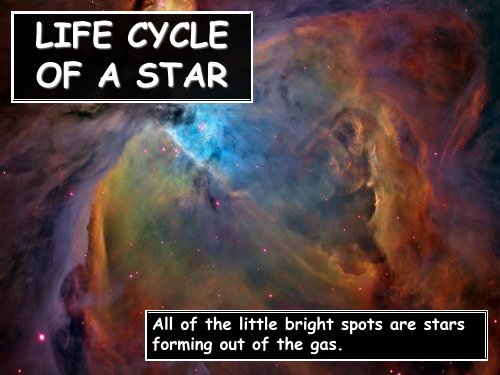Create successful ePaper yourself
Turn your PDF publications into a flip-book with our unique Google optimized e-Paper software.
<strong>LIFE</strong> <strong>CYCLE</strong><br />
<strong>OF</strong> A <strong>STAR</strong><br />
© 2004 Plano ISD, Plano, TX<br />
All of It the is an little area bright of dust spots and are gas stars in<br />
forming space out where of the stars gas. are This “born”. is a nebula.
Life Cycle Of A Star<br />
Stars change and evolve in a<br />
predictable pattern over time.<br />
The path a star takes over its<br />
lifetime depends on the star’s<br />
MASS. I.<br />
© 2004 Plano ISD, Plano, TX
The Nursery<br />
All stars begin their life in a<br />
NEBULA.<br />
A nebula is a gigantic cloud of<br />
dust, gas, and plasma in<br />
space.<br />
II.A.<br />
If there is enough matter in<br />
the nebula, gravity will start<br />
to pull everything together<br />
into a PROTO<strong>STAR</strong>.<br />
A protostar is an infant<br />
star…the equivalent of a<br />
newborn baby.<br />
© 2004 Plano ISD, Plano, TX<br />
III.A.<br />
The Horsehead Nebula
Average Stars<br />
Average stars spend most of<br />
their lives as boring, normal<br />
MAIN SEQUENCE stars.<br />
Our sun is a great example.<br />
It is about 4.5 billion years<br />
old.<br />
Average stars can live up to<br />
10 billion years before they<br />
begin to die out.<br />
IV.A.1.<br />
They create heat and energy<br />
through the process of nuclear<br />
fusion.<br />
IV.A.2.<br />
© 2004 Plano ISD, Plano, TX
Average Stars<br />
As an average, main sequence<br />
star gets older and larger, it<br />
becomes a RED GIANT.<br />
This means the end is getting<br />
near.<br />
Red giants are incredibly<br />
massive and bright, but are<br />
relatively cool compared to<br />
younger stars…the fire is going<br />
out.<br />
IV.B.1.<br />
When our sun becomes a red<br />
giant, Earth will look like<br />
Mercury.<br />
© 2004 Plano ISD, Plano, TX
Average Stars<br />
Eventually, the fuel for the<br />
nuclear reactions at the heart<br />
of the star runs out.<br />
Average red giants simply<br />
collapse in a “puff” of gas.<br />
What’s left behind is a small<br />
core of carbon and oxygen<br />
called a WHITE DWARF.<br />
IV.C.1.<br />
A small amount of heat is still<br />
produced, like an oven that’s<br />
still warm after its been<br />
turned off.<br />
Sirius A and B<br />
© 2004 Plano ISD, Plano, TX
Massive Stars<br />
Massive stars are much larger<br />
and brighter than their<br />
smaller relatives.<br />
Massive stars will spend much<br />
of their lives blueish-white<br />
because they are so hot.<br />
Eventually, they will make it<br />
to the RED SUPERGIANT<br />
stage as they age and cool.<br />
This is just like a red giant<br />
except bigger and hotter. A<br />
LOT bigger and hotter. V.A.1.<br />
The constellation Orion has<br />
two red supergiants in it.<br />
© 2004 Plano ISD, Plano, TX
Massive Stars<br />
Red supergiants don’t “puff”<br />
away when they get older like<br />
their smaller relatives…they<br />
explode.<br />
This SUPERNOVA ejects gas,<br />
radiation and a blast wave far<br />
into space.<br />
V.B.1.<br />
It will light up the skies for<br />
weeks or months.<br />
A supernova will briefly<br />
outshine its own galaxy when it<br />
explodes.<br />
© 2004 Plano ISD, Plano, TX
Massive Stars<br />
NEUTRON <strong>STAR</strong>S are one of<br />
the possible leftovers after a<br />
supernova.<br />
In a neutron star, all the<br />
leftover matter from the<br />
massive star is crushed and<br />
condensed down to a core<br />
smaller than the Earth. V.C.1.<br />
They are extremely dense and<br />
have tremendous amounts of<br />
gravity.<br />
Neutron stars are also known as<br />
PULSARS because of the pulses of<br />
gamma rays they give off.<br />
© 2004 Plano ISD, Plano, TX
Massive Stars<br />
The last option for a massive<br />
star is the most frightening.<br />
The largest of the massive<br />
stars have so much mass that<br />
after a supernova, the<br />
leftover material collapses in<br />
on itself to form a BLACK<br />
HOLE.<br />
There is so much gravity<br />
created by the density of the<br />
leftover material that a hole<br />
in space is ripped open. V.D.1.<br />
Not even visible light can<br />
escape.<br />
© 2004 Plano ISD, Plano, TX
Life Cycle Of A Star<br />
© 2004 Plano ISD, Plano, TX
© 2004 Plano ISD, Plano, TX
















